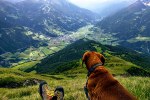News
No landscape to be seen
On 10 February 2019 Switzerland will be addressing an issue of truly fundamental importance, namely land. This is the date on which the Swiss will vote on a popular initiative submitted by the Young Greens. New building zones should only be allowed if a compensating area is created elsewhere, together with a “compact” residential development of already built-up areas and the promotion of sustainable forms of living and working.
One square metre of cultivated land is lost in Switzerland every second. Motorways, according to the Swiss Traffic Club, have an especially dramatic effect on the landscape: they have grown by 65% since 1980. The total length of railway lines has remained almost unchanged, however. Proponents of the national popular initiative “Stop urban sprawl – for sustainable urban development (sprawl initiative)” want to stop the wasteful use of farmland, green spaces and natural landscapes. Opponents reject the initiative as overly radical and rigid. Their concern is an economy that continues to thrive, meaning more homes, supermarkets, industrial buildings, roads and car parks. Other Alpine countries are witnessing development similar to that in Switzerland: nowhere in Europe is more fertile land consumed for residential development than in Austria, with an area the size of the city of Salzburg lost to building every year.
When growth causes harm
Permanent use is essential from an economic perspective. The notion is that only if it has an economic use will landscape have a value: it thus becomes a resource. From artificial snow-making for winter tourism to the overexploitation of meadows and deforestation, economics shapes and influences how forest, snow and landscape are represented in the Alps, says Irmi Seidl, lecturer in ecological economics at the ETH and the University of Zurich, head of the Swiss Federal Research Institute for Forest, Snow and Landscape and member of the “sounding board” of CIPRA International. She continues: “If we look at landscapes today, every single one is settled and used for agriculture.” It is always the economy that determines how these areas are used: “As the economy grows, it consumes more resources – and thus more landscape.”
According to Seidl, there is little evidence of any decoupling of economic growth and resource consumption. The ever more extravagant use of resources threatens the very ecological basis of life in our society. “Today all environmental policies are in fact subordinate to growth.” This means yes to environmental policies, but not at the expense of growth. But such growth cannot last forever, as shown by the slump in the construction industry in several parts of Switzerland.
We are therefore more and more in need of alternative economic models that are less excessive in their demands and less subject to economic fluctuations. One possible approach is sufficiency, explains Seidl: “Sufficiency requires that you seek the right balance and make sparing use of existing resources.”
In its web dossier “Nature and People”, CIPRA is collecting good examples from all of the Alpine countries that show that an economically and environmentally sustainable approach to landscape is in fact possible.
Sources and further information:
www.zersiedelung-stoppen.ch (de, fr, it), www.nzz.ch/schweiz/die-zersiedelungsinitiative-auf-einen-blick-ld.1448742 (de), www.wienerzeitung.at/themen_channel/wz_reflexionen/vermessungen/859658_Raubbau-an-der-Landschaft.html (de), www.cipra.org/de/dossiers/natur-und-mensch/landschaft (de, fr, it, sl)



